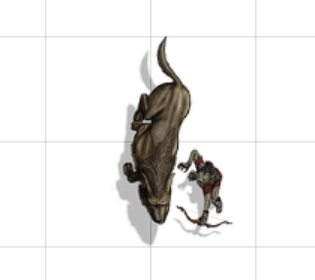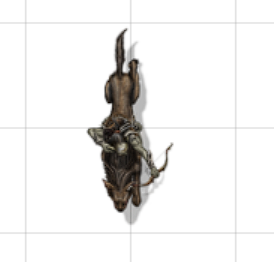Rules as written, you share space
That's a provocative statement given that there is no rule that directly addresses the rider's space in the mounted combat rules, however, there are two features that only work if the rider shares space with the mount.
As Kirt points out, the last sentence under Controlling a mount states
In either case [controlled or independent], if the mount provokes an opportunity attack while you’re on it, the attacker can target you or the mount.
And the second bullet of the Mounted Combatant Feat
You can force an attack targeted at your mount to target you instead.
Both are examples of specific beats general and while not actually stating it directly, only work if the rider shares space with the mount.
A Practical Guide
RPGBOT has a good article addressing this issue, "DnD 5e – Practical Guide to Mounted Combat" that presents three methods for handling the rider's space on a mount, what he calls the "Mearls Method", "Blob" and "Center of Mass".
It doesn't matter for small creatures on a medium mount
For small creatures on a medium sized mount, all three methods work the same - you and your mount share the same square.
Independent tokens (the Mearls method)
It appears from your diagram that your DM is using what RPGBOT calls the "Mearls method", from a tweet by Mike Mearls.
I have used this method simply as a token on a battlemap has to be in a square. Given that a Sage Advice question asked,
While mounted on a large creature, are all creatures within 5 feet of your mount considered within 5 feet of you?
and Mike Mearls answered,
no - still use your own reach. #wotcstaff
it is understandable that this might be the method used.
Here, the goblin has mounted the warg, but they're two independent tokens (or figures).
If the medium rider is considered to be in one of four squares on a large mount, like in your diagram, then you would have to move around on the mount to reach opponents not adjacent to your square. Your reach and range are determined from your square.

Share Space (RPGBOT's Blob method)
You could instead use a token with an image of both the mount and rider and assume they share space - effectively, you are same size as the mount. Any enemy that can target your mount can target you and you can target any creature adjacent to the mount. Your reach and range are determined from the shared space.

RPGBOT's Center of mass method
This is sort of a hybrid of the previous two that tries to limit some of the awkwardness of huge and gargantuan mounts when sharing space.
Discuss with your DM
You might discuss with your DM how your group wants to handle this. The shared space method is the one supported by the rules, but a DM may want to rule differently.


